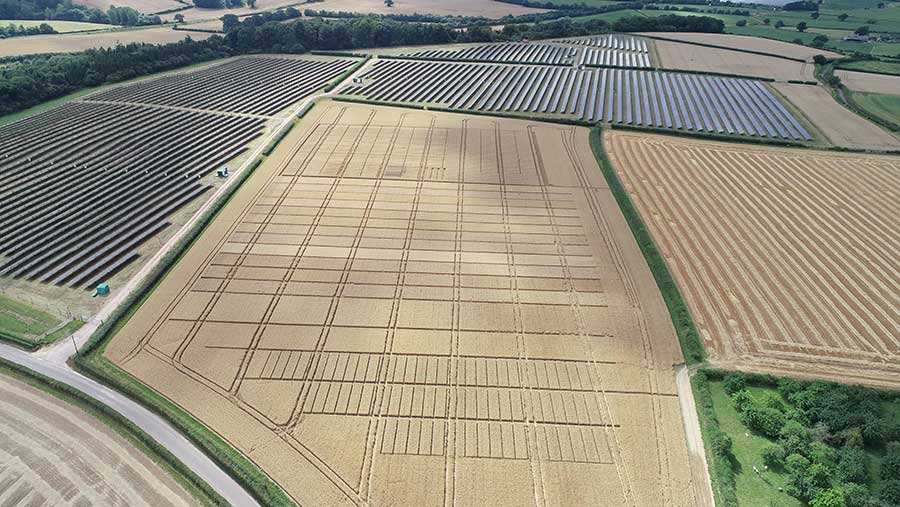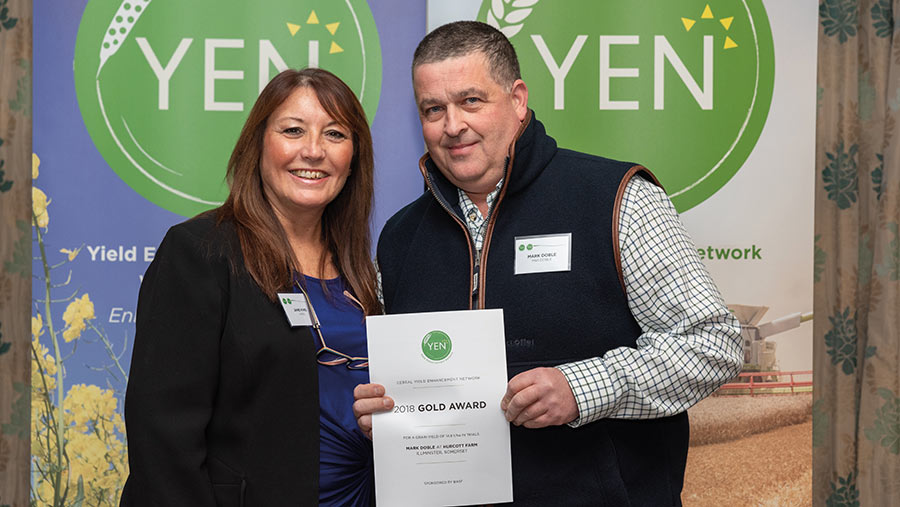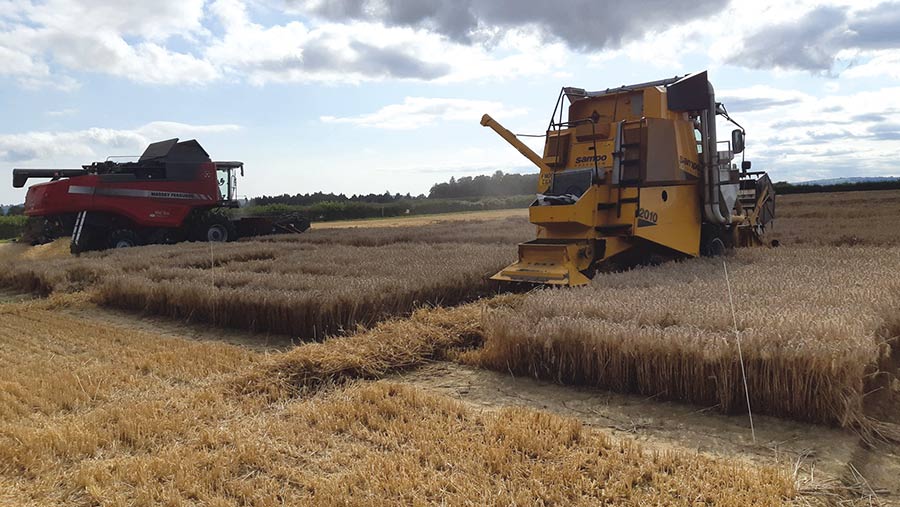Somerset grower wins gold with precise wheat production
 © Mark Doble
© Mark Doble Fine-tuning micronutrients, perfecting spray timings and use of the latest technology helped Somerset wheat grower Mark Doble win a top-yield prize in the West, for the second year running, with a harvest of nearly 14t/ha.
On-farm trials investigating the best choices of winter wheat varieties and fungicide treatments to keep the wet weather disease septoria at bay also helped pave the way, as local data is often limited.
“Carrying out the trials has allowed us to see at least a year in advance what varieties and chemistry work well under our own situation and management,” he says.
This all saw Mr Doble, who operates 160ha of arable land at Hurcott Farm near Ilminster, grow a winning yield of 13.9t/ha in 2020 from the variety Graham in the Yield Enhancement Network (YEN) competition, organised by crop consultants Adas.
See also: How a Cornish mixed farmer won bronze in wheat YEN competition
Farm facts – Hurcott Farm, Ilminster, Somerset
- 160ha arable land
- Cropping includes: wheat, barley, potatoes, oilseed rape, winter linseed, spring beans and maize
- Sand/clay brash soils
- Home to a range of variety trials
- Wheat crops grown on contract for seed
- Entered YEN four years running and awarded:
• 2020: Gold (13.9t/ha – West)
• 2019: Gold (15.9t/ha – South West)
• 2018: Gold (trials)
• 2017: Bronze (trials)
His success came despite a tricky growing season with a wet winter and dry spring, which saw his top wheat yield down by 2t/ha on the previous year.

Mark Doble at the YEN Conference, with Jane King of AHDB © Mark Doble
Key to success
The prize-winning YEN wheat crop was sown on 23 October with a power harrow-drill combination at a 190kg/ha seed rate, following a pass from a sub-soiler and a preceding crop of oilseed rape.
“We usually aim to drill wheat from the first week of October, but due to such wet weather conditions we were unable to go any earlier,” says Mr Doble.
For the past 30 years, the farm has been home to a number of variety and fungicide trials.
More recently, it has hosted regional trials for agrochemicals giant BASF and agronomy firm Agrovista where 32 different varieties are grown.
The farm’s south-west location signifies a high alert for septoria, so choosing the best variety and fungicide is essential to keep this wet weather disease under control.
With this in mind, varieties Extase and Graham, with good septoria resistance, were selected and grown for seed on contract for seed supplier Frontier.

© Mark Doble
Disease control
Mr Doble follows a rigid fungicide regime, geared towards septoria control and with the latest agrochemicals used in the four-spray programme, which also provides indirect control of yellow rust.
Making accurate spray timings are a major contributor to his success, especially as the YEN plots saw a high total fungicide spend of £172/ha.
“It’s the attention to detail with spray timings, chemical choice and of course a bit of luck with the weather which allows you to make small gains, and it is this which make a difference,” he says.
The use of the smartphone app Xarvio field manager and its spray timer function, has greatly assisted accuracy.
The technology effectively predicts crop growth stages, so fungicides can be applied at optimum rates and times in order to promote crop efficiency and alleviate crop stress.
Product choice is an important factor in controlling disease.
Two years ago, farm trials identified clear visual differences in wheat plots treated with Revystar (SDHI fluxapyroxad + azole mefentrifluconazole), which prompted Mr Doble to use the fungicide chemical as the basis of his T2 spray.
“The trial results with Revystar were stand-out different. Plots remained clean throughout which kept the whole plant greener. We could see a year in advance that it would work under our individual situation,” he adds.
Fungicide programme
- T0: chlorothalonil + metrafenone + epoxiconazole
- T1: fluxapyroxad + mefentrifluconazole + metrafenone + epoxiconazole + chlorothalonil
- T2: fluxapyroxad + mefentrifluconazole and pyraclostrobin
- T3: prothioconazole and tebuconazole
Crop nutrition
A total of 275kg/ha of nitrogen fertiliser was applied to the successful YEN crop, while conventional crops received 40kg/ha less.
The addition of 29kg/ha triple super phosphate (TSP) and 80kg/ha of muriate of potash (MOP) pre-planting also helped lift yields.
No farmyard manure is used in the rotation as livestock are no longer kept on farm due to the family selling its 100 head of beef cattle in 1998, but cover crops are now grown as a green manure.
Mr Doble has a particular focus on soil health and nutrition, where variable rates of phosphate and potash have been used for the past 15 years.
Soil sampling across the farm’s undulating sand to sand/clay brash soils is carried out every five years which proves beneficial, particularly as a section of the farm is home to a range of fossils with alkali soil conditions as high as pH9 in places.
Previous soil testing identified high levels of phosphate and potash in the soils of the YEN plot, with indices of four and two.
However, as last season’s wet winter conditions restricted root growth, an additional application of a liquid phosphate product in early spring was required.
This is because phosphate helps establish healthy root systems and stimulates plants to develop a dense collection of roots, notably in the early stages of crop growth.
An early plant growth regulator (PGR) application at the T0 stage also helps promote root mass and tiller survival, while a further PGR pass was made at T1.
Furthermore, tissue testing offered through the YEN programme flagged up a few minor deficiencies of magnesium, zinc and boron, triggering Mr Doble to take additional micronutrient measures to push up nutrition levels.
“Tissue testing accounts for seasonal influences, helping to supply crops with the right nutrient levels.
It’s this extra attention in nutrition management and the incremental improvements which make yields count and leads to better overall performance,” he says.
Mr Doble says that farmers are constantly learning, which is why it’s important to not be afraid of trying new and different things.
“We are currently considering testing grain and analysing results to help us further identify what trace elements should be applied to the crops to improve yields even more,” he adds.
BYDV control
Despite being in the South West hotspot for barley yellow dwarf virus (BYDV), the disease generally isn’t too much of an issue.
“Because of the bad autumn last season, wheat crops were drilled considerably later than usual, by about three weeks, so aphid pressure was notably down,” reports Mr Doble.
Aphid control involves spraying off any previous volunteers to remove the green bridge, and an application of the synthetic pyrethroid insecticide esfenvalerate at the two- to four-leaf stage in November.
However, he admits that as these insecticide control methods are coming under increasing scrutiny from environmental and governing bodies, alternative control methods may be required in the future.
Weed control
As crops are grown for seed, preventing blackgrass is paramount, so weed populations are kept at bay with careful procedures in place, especially after an extra two fields contaminated with the grassweed were taken on.
On these new fields, wheat and maize are grown which goes straight into a local anaerobic digestion plant cut by a forager.
The farm’s combine doesn’t enter the field, preventing any contamination of weed seed spreading to other crops.
A standard herbicide programme is used on wheat crops with a post-emergence spray in the autumn and a broadleaved spray at T1, with mayweed the main weed issue.
